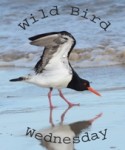Posted by: Ken @ 4:54 am
On June 17, a few days before we returned to Florida, Bob Andrini, President of the Kane County Audubon, led four of us on a “ramble” through Prairie Green Wetlands, a publicly-owned preserve in Geneva, Illinois (see Map). We got out very early because the temperature was expected to rise to 100 (F) by midday. Illinois was in the throes of a record hot and dry spell. For nearly the whole month of July, it was often ten degrees hotter than back home in south Florida. The corn crop was in danger of complete failure.
Tenant farmers still plant 300 of the 580 acre preserve in corn and soybean. Soybean is the crop in the foreground as we entered from the east. While soybean is somewhat drought tolerant, many of the corn stalks have not even created silk, the essential step before pollination and setting of kernels. The growth of the corn stalks is stunted and the leaves are curled because of the lack of water.

To the south (our left) is a fence line hedgerow, and beyond that part of the preserve’s 100 acres of restored tall grass prairie. It produced several bird species, including House Finches, Song and Savannah Sparrows, and many Red-winged Blackbirds. We heard and caught fleeting glimpses of two Sedge Wrens.
Dickcissels sang all around us. The yellow on this one’s breast was unusually clear and extensive.
Indigo Buntings were in full song, but showed signs that they were molting into their drab fall plumage.
We walked westward past the crop fields into an 80 acre wetland area that is normally a moist grassland, but the soil was dry and brick-hard underfoot.
In past years a pair of Yellow-headed Blackbirds had nested in the sedges and cattails that surrounded a small lake at the far western end of the preserve. The drought has caused the lake to shrink to not much more than a puddle of water. The former lake bed is shriveled and dry. The Yellow-headed Blackbirds did not return this year.
As we approached what was left of the pond, we heard the sound of water splashing and expected to see a flock of ducks fly up from the surface. Instead, we realized that the noise came from hundreds or even thousands of small frogs attempting to escape from us. The pond looked as if it were full of rocks, until the little frogs started jumping.
The amphibians were clearly in great danger from dehydration and were easy prey for herons and other predators.
Some, like this one, had not fully emerged from the tadpole stage.
Others seemed mired in the sticky mud. Note that there is something that looks like a cluster of small white elongated ovoid objects on its abdomen near the fold of its left thigh. They resemble the cocoons of parasitic wasps such as those that lay their eggs on caterpillars such as these, depicted on a tomato hornworm. I could find no reference to such a phenomenon, so I am possibly misinterpreting the image. Click to enlarge to full size if you wish to examine the cluster more closely. 
Around the margins of the pond, several Semipalmated and Least Sandpipers foraged. Leg color helps distinguish the two sandpiper species. The Least Sandpiper, on the left, has yellow legs while the Semipalmated species has black (but is this actually a Least Sandpiper with muddy legs?). See this informative article by Cameron Cox, in which he points out that the Least Sandpiper tends to point its bill more nearly straight down while foraging as opposed to the Semipalmated Sandpiper, which extends its neck further away from its body. This photo does illustrate a difference between the two species, though it captures only an instant in time.
This Semipalmated Sandpiper’s grayish back contrasts with the warm brown of the Least Sandpiper. Mud on its bill makes it look fat and bulbous. This appearance has accounted for some false reports of very rare Spoon-billed Sandpipers.
Least Sandpipers tend to forage around the edge, though they may wade in up to their bellies. This one checks out a frog…
…as a Semipalmated Sandpiper walks by. Its bill, clean in this case, appears heavier and straighter than the dainty droopy one of the Least Sandpiper.
One sandpiper stood out as appearing a bit larger than the Least and Semipalmated Sandpipers. It was possibly longer-winged, but the tips of the wings did not extend beyond the tail tip as would be expected in a Baird’s Sandpiper. It had a rather prominent dark area on its neck and upper chest. Might it be a Pectoral Sandpiper, or since it is seen between two smaller Least Sandpipers, just a larger-appearing Semipalmated? We could not concur on its identity.
Here is a closer look at the (so far) unidentified sandpiper.
The white breast of this Spotted Sandpiper extends upward in front of the wings. Barring on the wing coverts suggests that is a young bird. It briefly chased after a frog, but did not catch it. 
Here is a closer view of the Spotted Sandpiper, with a small prey item in its beak.
A Killdeer flew in and foraged in the dry lake bed. Its feathers appear worn, ready for the post-breeding molt.
I would have expected many herons to be gathered around to feast on the frogs, but only a lone Green Heron flew up. Its streaked breast indicates it is an immature bird. 
Like the Killdeer, the Dickcissel sings out its name. 
Posted by: Ken @ 5:59 am
This is my photo submission to the weekly Bird D’pot (Bird Digital Photography) meme hosted by Anni at I’D-Rather-B-Birdin’.
It is relatively easy to identify birds in their normal habitat. It’s a bit like going to a cafeteria where there may be little variety in the food selections. You just don’t expect to see an exotic dish.
Dickcissels are birds of the grasslands, where I can pick them out at first glance. When this one showed up in a woodland, the game changed. Suddenly it was just a strange sparrow-sized yellowish bird. I struggled to see the shape of its bill as it moved furtively among the leaves of a tall oak tree.
Some kind of vireo came immediately to mind, but this bird jumped from one branch to another as it actively gleaned insects, unlike the methodical movement of vireos. Was its bill long and sharp as that of an immature or female oriole? Thick as would be expected in a tanager, or conical in a finch? Did it have wing bars or tail markings? It seemed to have a faint yellow line over its eye. I kept switching between binoculars and camera, hoping to document it and possibly capture its field marks.
Frankly, I was not sure of this bird’s identity until, in between brief sightings, I enlarged the camera view. Luckily, I caught a partial image as it moved between the leaves. A finch-like bill, sparrow-like back, and chestnut shoulder patches were its distinctive features. This female Dickcissel was roosting in a wooded area in Hawk’s Bluff Park, Batavia, Illinois. There is a small area of grassland adjacent to this section of the woods. I had never before seen a Dickcissel at the park.
Only after being properly identified, it settled on a leafless twig and gave me a dozen nice open views.



Posted by: Ken @ 5:46 am
Here is my first photo submission to the weekly Bird D’pot (Bird Digital Photography) meme hosted by I’D-Rather-B-Birdin’
It is an Eastern Meadowlark that I photographed last Spring at Nelson Lake Marsh/Dick Young Forest Preserve in Kane County, Illinois. It was just selected by Cornell Laboratory of Ornithology to illustrate the “Bird of the Week.” (And I didn’t have to enter any contest!)
I find it so relaxing to look out on an open space. Growing up in the New Jersey suburbs, our sky was defined by the roof lines of neighbors’ houses (see my theological musings in this post: The Earth is Flat). While living in Dallas, Texas, our home was hemmed in on all sides by privacy fences.
No surprise that when we retired to New Mexico, I selected a lot with an expansive view of the forest and distant mountains, and designed a home with windows placed to take maximum advantage of the scenery.
Moving to Florida and desiring another window on the natural world, we limited our choices to homes on the water. When deciding on a second home in Illinois, we were less selective because we regarded it as a substitute for a hotel room when we visited our family there, a “crash pad.”
Here’s our front yard with an added “twist.” This is the view to the south from our front door as a storm front moved in from the west in late June. The single family homes in the background are newly constructed.
A wall of shelf clouds preceded this severe thunderstorm, on June 29, 2012. The spaces between the cloud layers created white ribbons that stretched 180 degrees across the sky from north to south. This is the view looking north as the clouds advanced.
As the storm rolled in, a Horned Lark, perched on a faded utility marker in front of our home, allowed my close approach as it braced against the wind.
Earlier in the spring, the male Horned Larks performed their flight songs as the females perched nearby.
Our Illinois town home was part of a planned 140 unit development, but hard economic times caused the builder to abandon the project after constructing only 40 units. Building codes required that the infrastructure had to be completed before the first homes could be built. All the topsoil was scraped off a former cornfield, an area the size of three city blocks. Before the project was halted in 2007, roads had been graded and paved, street lights installed, and utility service lines were run to the sites of each of the planned living units. As an unintended side effect of the developer’s misfortune, the disturbed land has now had about 8 years to return to grass.
To reduce the threat of wild fire, local codes also require the vacant land to be mowed at least once a year. This eliminates growth of tree seedlings and also encourages the ground cover. Our “back yard” now hosts quite a variety of bird species. Unfortunately for the birds, the renewed demand for housing has caused the developers to resume plans to complete construction of the remaining units. Groundbreaking was scheduled to begin this spring, but so far nothing has happened. Perhaps financing is again an issue. Hope springs eternal!
This past week a family of two adult Sandhill Cranes with their twin colts attracted my attention with their raucous calls. They probably nested at nearby Nelson Lake. I took this photo from our front doorstep. All these photos were taken within a few steps from home.

The delay in construction has allowed our local birds at least one more breeding season. Spring rains create temporary puddles (local birders call them “fluddles”), attractive to Spotted Sandpipers that remain to nest here.
While they do not breed here, other waders such as this migrating Solitary Sandpiper also stop to forage in the fluddles.
In addition to the larks and sandpipers, the open fields are host to the nests of Savannah Sparrows, …
…Vesper Sparrows, …
…Red-winged Blackbirds, …
…American Goldfinches, …
…Eastern Meadowlarks, …
…and Killdeers, here engaging in a courtship display.
Here is a series of images from yesterday morning’s walk at Nelson Lake/Dick Young Forest Preserve in Kane County, Illinois. The water level in Nelson Lake was very low and there were extensive mud flats. While I was observing the hundreds of Killdeers and a few peeps that were congregated along the edge of the water, I photographed them from the east observation deck.
The total unobstructed view was about 110-120 degrees. This panoramic image, stitched from three separate overlapping photos, includes 108 birds that can fairly safely be counted as Killdeers. There are 9 other birds that look like sandpipers, and 5 blackbirds and starlings. (To better visualize the birds and perhaps provide a more accurate count, click on the photo and select the original size image.)
I suddenly saw two adult Bald Eagles fly in and appear to be circling a small area near the middle of the remaining lake, about 1/4 mile away. As they were beyond the range of my 10x binoculars, I found it difficult to determine the exact prey that these two eagles were trying to catch.They seemed to be hunting cooperatively, taking swoops at what looked like a female Mallard accompanied by a smaller but longer-necked bird that looked like a Pied-billed Grebe. There appeared to be several ducklings in the water and in the grass that is now growing out of the shallow water.
I captured this image just as one of the eagles hovered overhead the prey and the other flew in low from the right and appeared to be aiming for one of more of the ducklings. (Again, click on photo for enlarged images.)
The “attack” eagle apparently missed its target. Either the duck or the eagle caused the splash that can be seen in this photo, taken less than one second later than the first.

The eagles circled and a few seconds later attacked a second time. The photo reveals that there is a long-necked swimmer next to the adult duck– I believe it may be a Pied-billed Grebe.
Less than a half second later, the “attack” eagle closes in.
It appears to be aiming for the ducklings (or baby grebes?) that are gathered at the edge of the grassy area to the right of the adults. Again, note that there are two (apparent) adult birds.
The eagle lifts off– I thought it missed the target again, as its talons appear to be empty.
However, this photo, taken 32 seconds later, shows that the second of two cooperative attempts appeared to have been successful, as the first eagle departed with a small prey item– a duckling? (I had to greatly sharpen the image to better demonstrate the eagle’s talons holding the prey). 
Only eleven seconds later, the other eagle makes a pass for the ducklings and they are seen diving to safety. Here the fleeing adult looks more like a grebe than a duck.
Finally, the second eagle circled and then departed the scene.

























